Currently only excerpts & illustrations from the last 13 issues
(numbers 43 to 55) are on this site.
Scroll down to view the June 2000 issue. Click on the numbers to view other issues.
Info about the current book on the arts
|
 |  |
 A listing of the contents 1992 - 2002 >> (numbers 19 - 59)
A listing of the contents 1992 - 2002 >> (numbers 19 - 59) |
Contents List |
 |
excerpts & illustrations
(The full articles are only available in the printed magazine. Click on "subscribe" for more info.)
|
number 52
June 2000
News & Letters
pages 2 - 4
UK Bahá´í Arts Academy 2000 in its 8th year
29 July - 5th August, Sidcot School, Somerset, U.K.
Courses for students of 15 years upwards, for four hours of class per day, in: Creative Prayer (Sarah Clive), Dance (Anna Staudt),
Graphic Design (Peter Maguire), Healing Arts (Ann Hall King), Music Theatre (Simon Sharp), Photography (Tom Fox), Raku-Ceramics
(Peter Lee), Singing (Richard Leigh), Writing (George Ballantyne).
|
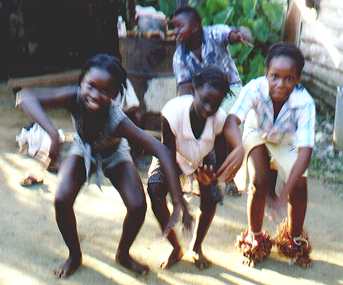
Children dancing variations of the Awasa dance,
Paramibo, Suriname, 1999. Photo by Jessy Rahman,
The Netherlands.
|
Email margaretappa@hotmail.com for more information.
Images Sought for books by Kalimat Press
Kalimat Press, an independent publisher of books on Bahá´í history, scholarship, community development, biographies, and deepening materials, is seeking images by Bahá´í artists which would be appropriate for use on book covers. Please send photographs of your artwork (color preferred) electronically as tif or jpeg files to:
kalimatp@aol.com, or by regular mail to: Kalimat Press, 1600 Sawtelle Blvd., Ste. 310, Los Angeles, CA 90025, USA.
You will receive a response but publication is not guaranteed.
Little Pond programme for June - August 2000
A meeting place
for the Literary, Visual & Performing Arts
Costs: $150/weekend, $395/week-Includes food. Accommodation available.
Visa & MasterCard accepted-Registration is limited so please reserve now.
- May 26, 27, 28
The Sacred in the Ordinary, Jay O'Callahan:
From Lincoln Center, New York, to the National Theatre, London, Jay has shown himself to be, according to Time Magazine, a true "Genius" of storytelling. A weekend with Jay and the art of storytelling. You'll never be the same.
- June 23, 24, 25:
The Caravan Project & Delicious Movement, Eiko & Koma:
MacArthur Award-winning dancers & choreographers, Eiko and Koma are world renowned for their Nature-inspired and zen-like meditational dance. An engagement with artists whose work is intimate, profound, transcendent.
- July 7, 8, 9:
Bharatanatyam-the Classical Dance of South India, Mimi Janislawski:
myth, history, art, music and poetry, united in dance. Mimi graduated from the Royal Ballet of London and is an exemplary exponent of the work of Balasundari of Klakshetra and the late T. Balasarasvati.
- July 17-23:
Art & the Mystic Path, Bill George & Sally Cordova:
Little Pond Co-Director and international award-winning theatre creator, Bill George, joins partners with choreographer, painter, Sally Cordova, to explore the process of prayer and creation from the Bahá´í perspective of "work as worship".
- July 28, 29, 30:
Drawing Towards God, Mickey McGrath:
Drawing is a prayerful activity that grounds us in the present moment and offers us a deeper awareness of the presence of God in our hearts and souls. Mickey is an internationally known artist and presenter who works full time in the ministry of art.
- August 4, 5, 6:
The Music of the Psalms, Larry Lipkis and Chava Weissler:
Moravian Composer in Residence and member of the nationally famous Baltimore Consort, Larry Lipkis, joins partners with Lehigh Religion Professor, Chava Weissler, in a deep look at the Jewish traditions and "voice" of the Psalms. Participants should be able to read music. Be ready to sing and enjoy trying your hand at composing simple rounds.
Little Pond Retreat
92 S. Penn Dixie Rd., Nazareth, PA 18064 610-837-2741
e-mail: litlpond@fast.net www.littlepond.org
|

Once I Was a Willow performed on the 1997 Summer Solstice under a full moon at midnight by torchlight at the DeMenil estate on East Hampton,
Long Island. Choreographed and performed by Joseph Houseal.
A solo dance incorporating Noh, Kabuki and 'martial modern' elements. Issey Miyake made the costume. The vest is made of Noh kimono brocade and had
threads of bronze in it.
Once I Was a Willow was inpired by the legendary
Japanese poetess of antiquity, Komachi, and her response to a couple young
monks who challenged her understanding of transience.
She lived to be 100, half-mad, half-enlightened. Her response was
Like a root-cut reed
should the tide entice,
I would go, I think.
But now no stream asks,
no tide beckons.
Once I was a willow.
|
Pages 3 to 5:
Letter from Aaron Gervais, Canada.
I'm studying to become a professional drummer and African and African-diaspora percussion are major interests of mine. I've studied Cuban music, and I've also looked at some Eue music (Ghana, and Togo) through a class that I just finished called West African Music Ensemble at the local university. We looked at the Gahu, Kinka, and Kpegisu "drums" (i.e. musical forms/pieces) in that class.
The more I study African music, the more I love music you can
dance to. I also very much admire the way they compose and the entire musical aesthetic; it's very different from the classical European mentality, which is still the mainstream here, although I should mention that the tradition of songwriting is almost identical (at least in my experiences) in both musics, which definitely alludes to
the universal power of the voice and of poetry.
Having also studied European composition, I can say that, at least musically, both idioms arrive at the same thing (i.e. musical transcendence) through almost opposite means. For example, African music requires an audience to be complete whereas European music
doesn't necessarily...
Letter from Valerie Senyk, Canada.
I don't think the spirit of competition necessarily connotes being ego-driven. If we are to strive for excellence, that in itself presumes a kind of competitive spirit, even with ourselves. As for isolating out
dancers and actors as being ego-driven, that's ridiculous. The best acting comes when the ego is self-effaced, allowing a new persona to inhabit the actor. One must give up much of oneself (and use much of oneself) to create a living character on stage. I know poets, teachers, painters - people of all walks of life - who are clearly ego-driven. But so what. That's their spiritual battle.
At the same time, I don't think we fully understand what the ego is, because there are aspects of our ego that are necessary, and which have a job to do.
|
I'm not terribly knowledgeable about Freud's ideas, but even watching one's children develop, one sees the development of the ego and its importance at some stages. I think it's all in how we use it. Anyway, I get tired of the cliche that presupposes people like actors are ego-maniacs, when it's not specifically true to that calling and can be found in any endeavour.
As for competition, I think it's often the ego that stops us from being competitive in the sense of striving -that's a weak ego, one that's afraid to be hurt or to lose. One of the greatest mentors in my acting/theatre training, reminded me that we must not be afraid to make mistakes and fall on our faces as we strive, because if we don't allow ourselves to make mistakes, we can't allow ourselves to succeed either.
|
Letter from Bill George, U.S.A.
An Indian Pot--the inheritance of a culture embodied in an
aesthetic object. A point of view. Then, a different point of view, European, coming in from outside without the same premises, and therefore not valuing the priorities in the work - "it's fired in dung! I'd never be able to get away with that." What is "good" is determined by our world experience. Good is not an absolute (or it is an absolute, but we just can't get a big enough "world experience" to understand it fully).
|

Odotushuone / Waitingroom, 1998, by Leenakaisu Hattunen, Finland.
Hand made paper. She taught herself papermaking and now teaches this in Helsinki.
A lot of her work combines Bahá´í and feminist perspectives, -often with wit.
|
But a fascinating twist is to note that a gringo's exquisitely made cultural duplication is worth relatively little, while that same object fashioned by the hands of someone who more genuinely inherits
the culture, is real, alive, "spiritually empowered". Certainly there's a bit of this in the marketplace when we see the value of an artist's paintings go up after their death. It's not just a question, I believe, of the sudden limitation of product and therefore market increase in value; it's because of a subjective connection with someone of an unreal nature, of before yet now, intangible, the spirit. In a way, we are all one family, but I tell you, I have a much stronger feeling about what my own children do than about what the children of others do. I care much more about their work of art (no matter the product) than I do about the work of children in general. And so, their art work is of more "worth". It's emotional.
Letter from Joseph Galata, U.S.A.
The subject of pain and martyrdom is one of my favorite subjects.
‘Abdu'l-Bahá said the only purpose God created us for was to be happy.
In the Long Healing Prayer, the attributes are all positive:
Most Bountiful, Most Loving, Most Kind, Most Generous. Nowhere does it refer to God as the Great Tester,
the Cause of Suffering. ‘Abdu'l-Bahá's prayer reads:
"Oh My Beloved, if thou didst know what God had ordained for thee, thou wouldst fly with delight and thy happiness,
gladness and joy would increase every hour."
Increase every hour? What? Suffering? Pain?
When we are born, no matter to whom and what, we are all initiated into the fellowship of joy and pain.
We all get both, simple as that. Take them both and run with them. If we are attracted to pain, we get it. If we are attracted to joy, we get it. The Sufis, the Whirling Dervishes, dance away their pain to "erase" painful memories so they aren't attracted to more pain.
The concept of martyrdom scares people off in this country. We glorify it and we understand perhaps some of the spiritual nuances. But people aren't searching for new ways to be martyrs, people are searching for new ways to connect with God and to increase their happiness. I have found that if I talk to people too much about Bahá'í martyrdom,
they are turned off...
I hosted a major Sacred Dance Festival this weekend, with people of all religions using dance and music to worship and
join together in spiritual unity...
|
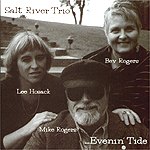
CD cover,
Evenin' Tide
by Salt River Trio, who are:
Lee Hosack,
Mike and Bev Rogers,
U.S.A.
Evenin' Tide, our first CD! One hour of original songs including three cuts appropriate for use at Bahá'í Feasts.
This CD features strong vocal harmonies woven throughout with acoustic guitars and harmonica.
The cost is $15.00 (including tax and shipping).
Checks and US Postal Money Orders may be made payable to: Beverly Rogers.
Address: 18 Bradstreet Lane, Eliot, ME 03903, U.S.A.,
email: mbrogers@cybertours.com
|
Letter from John Kavelin, U.S.A.
My own life is full of disorder and dissonance on occasion, and according to a shrink I consulted once, that is the place where real spiritual and emotional growth takes place!
So living in the tension, I have found, is exhilarating, challenging, exhausting, and educational. No one can
survive there all the time, but as artists one takes for granted a certain amount of uncertainty, because every blank page,
or canvas, or computer screen, or stage, is an opportunity to get immersed in the creative act, with outcome uncertain,
but with a love of the process of discovery, and most importantly, faith that the marriage of skills, trust, courage, curiosity, and perseverance usually leads to a new and original outcome that we have 'channeled' (you-should-pardon-the-expression) through our personal life's filter that makes that piece of art unique, authentic, and something outside/beyond ourselves.
In a religion that so strongly focuses on unity, this idea of embracing dissonance, or disorder, or process --
which one's artistic precociousness often requires and enjoys -- is foreign to some people who may be afraid of the
unresolved tensions and issues in their lives, and who were probably not encouraged to "embrace the shadow self", or to
'live with the question."
Certainly, for some of us who find a certain misalignment between our personal lives, styles of expression, or opinions,
and the majority view that may prevail in any given community of faith, we find we must live with some dissonance or
unresolved questions -- out of respect for our own process of discovery and becoming. 'Abdu'l-Bahá wasn't kidding
when He said life wasn't a picture gallery but
a workshop. As artists we may understand this at a different level than some, enjoying the reality that life is about process, not always about result.
When individuals and communities give up "impression management" for the deeper pleasures of expressing their authentic selves -- in process -- a new level of joy is reached that transcends the need to be "nice" and makes room for being real with each other.
|
Letter and poem from Cal E. Rollins, U.S.A.
If something like getting up in the morning and going for a walk immediately after breakfast to keep my blood sugar down due to diabetes is a spiritual battle, I might as well be imprisoned in Waterloo. And if turning on CNN to hear the latest god-awful world events before I thoroughly pray and meditate is one of my lost spiritual battles, I guess I've had it there too. But if I don't watch CNN first I won't be depressed enough to pray and win my battle. So like Rosanna Dana says:
"If it's not one thing, it's another."
|
Americanization of Beauregard
Cousin Beauregard tried settling
in Senegal, then France, but came back
cured of wandering and with a concept of home.
"He could parlez-vous with the best of 'em, "
Uncle Beauchamp said to me, holding
his fishing pole with both hands.
"But he couldn't fool nobody."
"Why didn't he like France? Especially Paris?"
"He liked 'em alright, but they didn't like him."
"Uncle Beauchamp, many blacks live there!"
"I suspect there's a difference 'tween livin'
and bein'.
He wasn't no Frenchman.
The Statue of Liberty was black, but French.
Not Beau. He too steeped in the American side
of history and politics.
And wastin' hot water.
He wasn't no African neither. Don't even
look like one."
Just then the catfish caught.
Review
pages 5 - 6
|
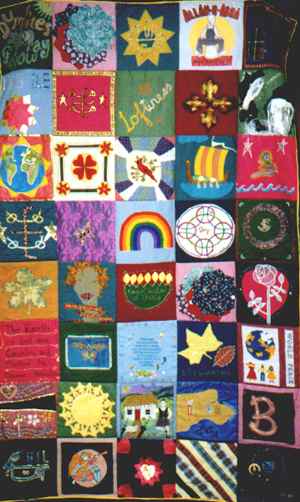
The Centenary Quilt, 1998 made by the Scottish Bahá'í community. It is a collective piece made to
mark the centenary of the Bahá'í Faith in Scotland. Each piece was made by a different community and some squares relate to the locations such as the
jumping salmon (2nd row on the right) from
an area famous for its salmon.
|
The Global Visions Arts Alliance WOW! (Women of One World)
performance at the Grand Canyon Bahá´í Conference
by Susan Lewis Wright, U.S.A.
Taking to heart the Guardian's directive that the Faith will
"spread like wildfire when its spirit and teachings are presented from the stage", and that the most
challenging issue facing the Bahá'ís of the U.S. is racism, Global Visions Arts Alliance was founded in December of 1996
to produce programs of artistic merit that best represent our Unity in Diversity. A fundraising concert with the renowned
singer Narges in December of 1997, the April 1998 One Human Family Gospel Workshop and Concert with Eric Dozier (which made the front page of both of Denver's daily newspapers as well as being featured on the nightly newscasts of 5 television stations), and a concert with Ahdieh (often called the Persian Barbara Streisand) last December were tremendous successes. The Ahdieh concert helped raise funds for GVAA's most ambitious project yet --
the WOW! show (Women of One World).
This multicultural, intergenerational cast of professional performing artists had its premier performances
Dec. 24-26 at the Grand Canyon Bahá'í Conference in Phoenix, AZ.
Friday night's show began with award-winning poet Della Frank from Gallup, New Mexico, who also chanted in her
native Dineh (Navajo) language. This was followed by a dance performed in the classical style of south India,
Bharata-Natyam, choreographed and performed by Adrienne Stengel of West Lafayette, Indiana. The dance depicted The
Moment before the Moment that Mulla Husayn received the revelation from the Báb. In a segment from her original drama,
"Three Women", Valerie Dana of Highlands Ranch, Colorado portrayed an Iranian woman whose son is imprisoned and then
martyred. Ava Bowers from Atlanta, Georgia followed the martyrdom piece with "Life-Giving Fragrance". Ava wrote the
music, the lyrics were from a poem written by a martyr while in prison waiting for his death sentence to be carried out.
|
She then sang the gospel tune, "In This Day, Bahá'u'lláh", with Archie Evans of Denver, Colorado, board member of Global
Visions. Ava and Susan Lewis Wright, Highlands Ranch, Colorado, sang the traditional version of "Ya Bahá'u'l Abhá".
As the echo died out, Stefanie Bouchard, a Cowlitz Indian from Soldotna, Alaska, led the rest of the women on stage
singing the Native American version of this while the women performed the shawl dance.
Saturday evening's performance began with poems and a chant by Della Frank, followed by Stefanie singing,
"Watching the Mother Die", about the death of indigenous cultures. Stefanie, Ava, Susan and Adrienne sang
the short version of the Healing Prayer set to music composed by Adrienne, with Larry Peterson on the bodran
(Irish drum). Ameria Jones of Little Rock, Arkansas, danced original choreography set to music and poetry
(Maya Angelou's 'Caged Bird’ ), ending with the song, "What About The Children".
|

Tlingit Sunburst
stained glass sculpture
by Chuck Larson, U.S.A. / Israel.
He pioneered to the Tlingit Indian village, Kake, Alaska in 1977,
and then took classes in stained glass. In 1998 he moved to
Haifa to help work on repairing glass panels in
the Shrine of the Báb. The sun,
a rare emblem in Tlingit art, is fashioned in units of 9.
|
Beverlee Patton, Eugene,
Oregon, performed her deeply moving monologue on the death of her mother, followed by Susan Lewis Wright
singing "Bird" while Ameria danced. Justice, company manager of the Diversity Dance workshop in Seattle,
WA, performed a rap on the Equality of women and men, written and produced by Jamal DeGruy, and performed
a break dance during the instrumental segment. Ava sang the song she wrote about Tahirih, "Destiny".
The evening closed with "Turn This World Around", written and produced by Susan Lewis Wright,
with Justice in a solo dance and backup ensemble dancing by 6 of the women, including Ameria's 9-year-old
daughter Aisha. During the long drum solo, the rest of the women joined in, and each woman performed a brief
solo dance representing various cultures - Persian, Native American, African American, Indian and so on.
Sunday morning's presentation included poetry by Della, songs by Stefanie and Ava, and a dance by America and
Aisha, concluding with a long and enthusiastic standing ovation.
Four members of the Board of Directors of Global Visions Arts Alliance made significant contributions to the
success of these shows: Susan Lewis Wright, Archie Evans, Bill Weddle and Larry Peterson. Susan, president of Global
Visions, was executive producer of the event and a performer. She and Bill Weddle had met with Beverlee Patton and
Earnestine Berkey of UnityWorks at Brighton
Creek over Labor Day 1998, and that meeting laid the groundwork for Women of One World...
Contact Global Visions Arts Alliance contact: globalvisions@bigfoot.com
to arrange a show or workshop in your area, write:
Global Visions Arts Alliance, POB 9006, and Denver, CO 80209 USA, tel: 303-546-3444, fax: 303-470-6655.
|
Artist Profiles
pages 6 - 8
Venancio Mbande, timbila musician, songwriter, Mozambique/South Africa.
|
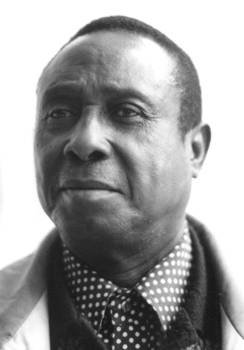
Venancio Mbande, 1999
Photograph by Yorum Diamand,
The Netherlands.
|
I don't know how I learnt the timbila.
(a large wooden xylophone-like instrument
-click here for a photo of timbula being played by the group Anumadutchi).
I grew up with it, learning to play from my elder brothers and from playing after school each day with my family in the Zavala district on the southern coast of
Mozambique...
...The timbila was mentioned by a Portuguese missionary in the 1300s and has been performed in the Manjacaze,
Zavala, Inharrime and Homoine districts of Chopiland for hundreds of years and on many different types of timbila.
Now there are only three types: the Chilanzane, usually consisting of 19 keys making it about a half by two and a
half metres long, the Dibhinda (bass) usually 10 keys, and the Chinzumana (double bass) which is usually made up
of three large 50 by 40 cm keys. The timbula keys are made out of Mwenjo wood with cut gourds underneath. They are
generally played from left to right and always very fast. The melody sits in the rhythm...
Like many young men from our area, after I
finished school, I went to work in a gold and platinum mine in Transvaal (South Africa). At this mine,
like many mines in the area, there was a Mgodo group (of 18 dancers and 15 musicians) and I joined this group, learning as much as I could from them. In 1953 I started my own group of 19 dancers and 19 musicians. At the same time I started making my own compositions and lyrics. I compose these lyrics for my own expression and enjoyment but others see them as political because they are songs about the times we
live in...
|
Some recent songs have been about landmines, about how old people are being abandoned by their children, and about
bandits stealing our cattle. I don't write against any government. Just about what has happened and the government
can see that too, so I have not had any problems as a result of my lyrics. People seem to love them and I think it is
because they recognise their lives in the songs...
|
pages 8 - 11
Lindsey Shields,
singer, songwriter, theatre,
Aotearoa / New Zealand.
|
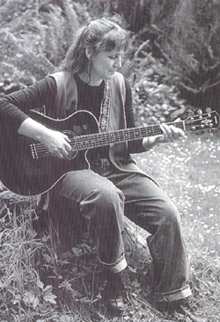
Lindsey Shields
|
I don't know why I write songs, but I know I have to. They come from an inner place. I feel as though some songs almost get themselves written! They come easily and are completed quickly. But others need discipline to get them completed and ready to "air" in public. I have a few at the moment that require discipline to get them finished.
I picked up a guitar for the first time when I was 15...
I'm still pretty rough on sight reading for guitar; I almost never do scales, and have to think hard to figure the names of some of my more wayward chords. I play what sounds right - progressions that I hear in my head or that come from experimenting with patterns on the fret board...
I came to song writing quite recently, in the last 10 years. When I was young, I cut my vocal "teeth" doing cover versions - Joan Baez, Judy Collins, Neil Young, Crosby Stills Nash, a bit of Dylan - but mostly I studied and mimicked Joni Mitchell's early work. She is still a significant hero of mine.
The title song for the 1996 cassette, "For The Trees", was written after I had left a small dying sawmilling town in western Southland. I was a teacher there, which was pretty difficult at times, with my being a solo mother and all. I remember going to a meeting between conservationists and the timber milling people, which was pretty tense...
|
"For the Trees" is my first recording, and it came about at a time when I was taking new directions. My two sons had finished school and were at university, living independently, and I was freer to pursue my own directions. In fact, I was studying at university too, and had been a guest at a few folk music festivals. I felt I had sufficient songs that were worth recording. This was made possible because I was earning enough money from playing regularly with The Pioneer Pog 'n' Scroggin Bush Band
("Pog Band")
(see: http://kiwifolk.org.nz/artists/pog/pogband.html)
...
|
Some of my songs take a lighter look at life, such as "PMT Blues". PMT is something that has bothered me much of my adult
life, as it does many women. Few seem to sing about it, yet it affects our lives, often seriously.
In this song, I take a more flippant approach, likening the release of the ovum to a train leaving a station,
with a build up of steam. I was fortunate to become acquainted with a woman, a fellow theatre student, who played the
harmonica on "PMT Blues". I've no idea where she is now, but she is immortalised on my recording!
Another song on the cassette (later released on CD when I could finally afford it) "Civil Emergency"
finds the funny side of an emergency situation: the way that people become inordinately disorganised when they have
to hurry; the fact that there are people just waiting for a good disaster so they can get busy "helping"; the inclination
of news media and politicians to zoom in for photo opportunities once the immediate danger is over, under the pretext of
surveying the damage in some pumped-up "important" way. Like Arlo Guthrie's "Alice's Restaurant", "Civil Emergency" takes
a small event in a southern New Zealand setting and builds the event up out of proportion.
Anything can be the raw material for a song, so there's a variety of subjects covered in my work.
It really depends what is grabbing my attention at the time - love, nuclear tests, school camp, relationship breakdowns, private and public violence, always with a personal response or a close focus. My song "Eugenia" deals with the troubles in Ireland, and happened as a result of my meeting the "Eugenia" in the song...
|

Carried Sleeping Spirit, 1999
Stone sculpture by Myriam Bargetze,
Liechtenstein.
|
...Lately, my music has followed themes of separation and dislocation. Since my visit to the UK in 1997,
I have been aware that it is still my home, even though my family came here when I was a teenager.
It was amazing to discover that I still had those aunts, uncles and cousins that I had loved as a child, and that
I was as much part of the family as ever, almost as if I had never gone away. Some have died, sadly, and my mother
has been dead now for several years. My need to make my pilgrimage seemed to grow after her death, and I had a strong
sense of my mother there when I was in Scotland. That's something I refer to in "Finding Home",
which I wrote after my return to New Zealand. I also had a feeling that I was taking something of my mother home.
I learned later that there is a protocol in Maoridom for that - kawemate, I think it's called. I
have no "story" for it in my own culture. I feel privileged to learn Maori things from living in New Zealand and I feel
I wouldn't have understood the significance of place and ancestry had I not been here.
So, my Scottishness is strong in me just now, and I was really lucky to be commissioned to write a song for
an Edinburgh-style Tattoo. This song was about the way we settle new places but bring cultural bits with us to maintain
some sense of belonging and connection. It's called "Echoes of Scotland". Here are some of the lyrics:
|
The old songs resound in these new hills
We dance the old kilted dances still
And for every ship that to these shores comes
New glens echo with the pipes and the drums ...
It's the same moon but a different constellation
The same sun shines in foreign skies
It's the same old earth, just a different location
The same heart beating down the generation lines
It's the same old heartbeat ...
|
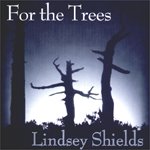
CD cover
For the Trees, 1999.
|
...I do various theatre things. I'm a member of the trust that did the play. It is a community-based group called "Talking House", which produces a variety of original work. I am also a member of the Dunedin Playback Theatre Company, a relatively recently formed group.
A project I have just completed with Talking House was a commissioned work that
Presbyterian Support Services funded for the International Year of Older Persons. Talking House are involved in creating
art in the community out of local stories, so this was a perfect project for us. We had two sources of material: one was
oral histories gathered from some local house-bound people; the other, a working group of old people who met regularly for
six weeks planning possible character "life-stories" and giving us anecdotes from their own lives. My job was script
writer - probably my most ambitious writing work so far...
|
pages 11 - 16
Jessy Rahman,
visual artist, arts co-ordinator, curator, The Netherlands.
Interview with Sonja van Kerkhoff, The Netherlands.
|
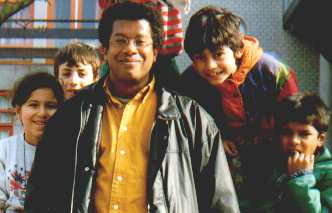
Jessy Rahman, The Hague, 1998,
during his Laws of Children project.
|
My 305 year old academy of visual arts in The Hague has a policy of inviting well known artists to give workshops, once every five years. In my third year at art school, Jannis Kounellis, a Greek-Italian and one of the leading arte povera artists, came to give a workshop for the
sculpture and painting students. At the time there were lectures, workshops and
performances.
During this, ten of us decided to work on the beach while all the other activities took place within the art school
buildings.
|
It was our reaction, in the spirit of arte povera and land art. We wanted to involve the public.
We decided to make a 3/4 circle form, ten metres in diameter and one and half metres deep. It was made spontaneously and in a sense was a direct response to the situation. It was winter and cold. So we made a shelter with materials found on the beach and with our bare hands. Once inside the form and seated, you felt protected from the biting winds that came direct from the sea, and at the same time, it created a nice micro-climate (a climate within a climate). It was so simple. The opening was physically necessary to create the micro-climate but also it was an opening or connection within the larger
picture...
|

Sculpture by Jessy Rahman and other art students, 1988.
|
...In 1968 Jessy's parents immigrated to The Netherlands from Suriname, with Jessy, a seven-year-old, and his five siblings. It was also a year of many protests, the most dramatic being when students in Amsterdam in protesting against the educational system took over the University registry office. It worked, because a lot of changes appeared. In the same year there was a 'beeldenstorm' (an iconoclasm, a term from the 1600's when Protestants destroyed paintings and statues in Catholic churches). Students in many art schools destroyed the Greek and Roman plaster casts. Until that year all the academies based their subject matter on Greek and Roman models. Later Jessy saw some of the leftover broken casts of Greek and Roman culture lying in the cellar of his art school.
...In his third year of art school, Jessy switched from studying painting to three dimensional studies. Here he had assignments to make works for public spaces and learnt how to prepare proposals. There were a few young guest teachers who got them to work in new ways with materials such as with polyester or welding steel, etc.
|
The Material Paintings, 1991 -92
Jessy made a series of paintings in which paint was only used when it was necessary...
The painting, 'Swiss Air', shows a cross made of lead strips on a red background (the Swiss flag is a white cross on a red background). And in this painting only the landing strips are painted. On two arms of the cross are two jets (models of the Euro fighter) whose
vapour trails have 'coloured' the rest of the cross white. So it seems that as the jets move, they "paint in" the Swiss Flag. Switzerland is located centrally in Europe at the intersection of many countries, and Jessy has made the white cross of the flag into two paths that intersect. It seems as if the two planes are competing, racing toward each other, heading for a collision. The cold war in the last 20 years seemed to Jessy more about competition than ideology.
The Euro Fighter, under development for about twenty years until the end of the cold war, was a major joint expense for four European countries. What one country does always affects other countries, ecologically, economically and politically.
|

Swiss Air,1991,
lead strips, paint, toy planes on board,
by Jessy Rahman
|
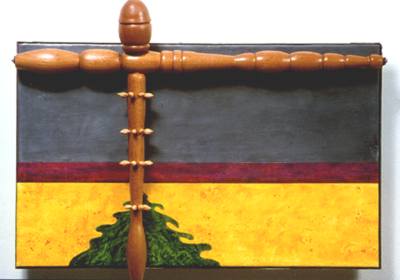
The Pardoner,1992, mixed media on board, by Jessy Rahman.
|
...Another material painting is ‘The Pardoner’. The title refers to one of the characters in The Canterbury Tales (which Jessy studied at high school) who sells holy relics to the other pilgrims. Later it transpires that he is a trickster.
This piece was a response to Jessy being asked to curate an exhibition of Surinamese artists living in the Netherlands.
The exhibition, "Transmovement", was a result of a political push for more visibility and integration of migrant groups
and Jessy was sure that he was asked because of his skin colour, and because he'd graduated from an art school in the
Netherlands.
This didn't make him an expert on Surinamese art.
|
Jessy said that he felt like Chagall, who when asked why he painted animals upside-down, said it was because of his background. It was a nice response but not an answer. Jessy felt as if he could tell any story and it would be believed because it was politically correct to do so.
I could be charlatan or a shaman, just like the pardoner in the Canterbury Tales. The art believers and the politicians were the other pilgrims. My interests were in the contemporary visual art world. Surinamese culture had no role in this. At the same time no one is an expert in everything. So in a sense we are all between learning and knowing. What was valuable from this experience was that I dived into my own Surinamese roots and learnt a lot about Surinamese influenced art and I met other artists with Surinamese backgrounds also living in the Netherlands.
The painting itself resembled a flag, but of no particular nation. The smooth mahogany wood, turned by Jessy himself, formed a cross-form (and on flags these crosses derive from Christianity). He chose this material and form to hint at the three-dimensionality in African sculpture smoothed by western machinery. This was a reference to Jessy's African blood as well as to his Catholic upbringing. Inserted into the wood were tropical plum pits - the living remains of fruit, serving as symbols for relics. For Jessy the insertion of the pits into the cross-form was also a reference to the piercing of Christ's body at the crucifixion. The background is a sheet of lead, a reference to Jessy's contemporary art influences, while the acrylic colours relate to his Surinamese Indian heritage (yellows, maroons and greens). The largest cultural group in Suriname are the Hindustanis.
Jessy used colourful two-dimensional elements for his Hindustani side, three-dimensional wooden and plant elements for his African and Catholic side, while the lead and clean craftsmanship reflected his European upbringing. He has topped it all with a title that raises questions about the issue of representation and presentation.
Flags
Flags have meanings that go much deeper than nationalism.
Often they are a metaphor for culture.“
Flags are a recurrent image in Jessy's work. ‘The Czech-Slovak Process’ is based on the Czechoslovakian flag. Two vertical panels, red and white, are divided by a blue funnel, inside which molasses have flowed down onto a chalk triangle set between two small trays. This triangle divided the flow, and made it visible (in contrast with the black molasses) so that the molasses flowed evenly to both sides of the flag. It was made in late 1990 when there was unrest between the Slovak and Czech peoples. This work was his wish for a peaceful resolution. The viscosity of the molasses showed the movement, the gradual division, into the two trays under each
panel.
Then there were the elections and Czechoslovakia divided without a war.
So my peace monument worked!
The Arts Collective - Quartair
Jessy was one of the founders of the artists' collective Quartair, which started in 1992 by squatting in an old
bakery in the centre of the Hague. They entered the building on the day that the Gulf War began and Jessy is sure that is the reason why they had so few problems with the police. In the Netherlands, if squatters follow the right
procedures they are allowed to remain in a building they have occupied. As it happened STROOM, the Hague City Arts Council, was looking for an exhibition space and so, ironically, the first exhibition in the Quartair Gallery was organised by the city arts council.
The exhibition they organised themselves in 1992, 'Two World Accents', involved artists from Germany and India. The collective has now made a contract to use this gallery space in the summer for their own projects, and in the winter months it is in the hands of the city arts council.
Quartair is now a platform for exchanges with arts groups in various countries. Often it involves an exhibition in their gallery which is then reciprocated. There have been exchanges with art groups in London, Berlin, Finland, Norway, Iceland, Arkansas, Suriname, Belgium, and India. The work often has a link to performance or installation. They also organise shows around a theme such as '750 metre Den Haag', (750 metres of The Hague) which was held the year the city celebrated its 750th anniversary. Installations by 20 artists addressed this theme in a variety of media. Another was '12x12', which was 12 hours of performances on June 12th 1999 by artists
from Europe.
|
In 1997 Jessy, as a member of Quartair, was invited by the Indian artist Bhaskar Hande for a two month residency in Pune (200km north east of Bombay). Six of them travelled there, giving workshops, having an exhibition and working in the studios there.
During this time Jessy travelled to the mountains to work with the figurative sculptor, Kapuskar. He worked with Maharastran clay. Mixed with dung and straw, this clay is a major building material in the area. Jessy wanted to use traditional materials for his work. Another was rangoli, the sprinkling of pigment on the ground. This was traditionally done to inform visitors where to go for their meeting, etc. It was a means of communication. In the big cities, such as Pune, now it is only made as part of school competitions, to see who makes the most striking design. This has nothing to do with how it was originally used but the form of sprinkling pigment is traditional and requires great skill.
Mandalas are made like this....
|

Detail: Rangoli, 1997,
ceramic, engraved sheet metal, pigment,
by Jessy Rahman and others.
|
|
Jessy chose fruit forms as the basis for this work for the exhibition, 'Holland/India, Give and Take in Art'.
Working with students from the school of architecture, Jessy asked them to choose a fruit and to cut it
in half and to draw these. From these drawings they all worked together on making rangoli fruit.
A large leaf made of metal was placed on each of the 4 rangoli fruit. At one time in India,
particular leaves were only used for people of a particular caste or status. For example a Brahman was
only allowed to eat from a banana leaf. Small seed forms out of copper and ceramic were placed on and around these metal leaves to illustrate that food can be presented in various ways, just as there were and are various
customs for eating....
|
pages 16 - 18
Philip Hinton,
actor, Australia
|
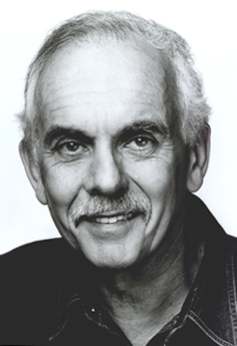
Philip Hinton.
|
Phillip Hinton was born in war-time Britain and grew up in Cape Town, South Africa to where his parents emigrated in 1947. After undistinguished years at school, in 1961 he became a member of the young Bahá'í Community of Cape Town and by some quirk of fate, was invited to join a professional
theatre company as an actor. At the age of 18, the idea of being both applauded and paid to show off was irresistible, and Phillip decided on the stage as a career path.
In 1963 he made his way to London, to attend the first World Congress of the Bahá'í Faith, held at the Royal Albert Hall, and to pursue his profession. There followed 12 years working first in repertory, on television and with some of Britain's leading directors in The Royal Shakespeare Company, the Chichester Festival Theatre, the Bristol Old Vic, and the Hampstead Theatre Club. In London in a musical comedy, he met a dancer, Ann Constant. They have been married for thirty-four years and have three sons, Sean, Simon and Benjamin.
The Hinton family moved to Australia in 1975 and Phillip has continued his acting career on stage, television, films and in radio drama. Recently, he has had guest roles in several US TV productions, The Flood, The Thornbirds - the Missing Years, Tanker Incident, Time Trax and Flipper. He is also in great demand as one of Sydney's leading 'voice over' artists in radio and television advertising and for documentary narrations.
|
In 1992 at the Second Bahá´í World Congress in New York, Phillip played the role of Howard MacNutt in the drama, Heralds of the Covenant, which was performed twice before an audience of 15,000 people in the Jacob Javits Centre.
The solo performance, Portals to Freedom, has toured major cities in Australia and USA, and has been performed at the Seat of the Universal House of Justice in Haifa, Israel and in London and Auckland.
Portals to Freedom, adapted by Phillip Hinton from the book of the same name, is the story of Howard Colby Ives who, in 1911 was a minister in the Unitarian Church. Ives was one of a number of leaders of thought and society figures who were privileged to meet `Abdu'l-Bahá during His visit to America in 1911/12. In 1937, Ives published ‘Portals to Freedom’, a detailed memoir of his days in the presence of the Master, which profoundly altered the course of his life. Ives left his ministry in the church to become a devoted Bahá'í. His days of spiritual search and discovery which involved a certain amount of anguished soul-searching are examined in this performance by Phillip Hinton.
Late in 1993 I had a call from a member of a Bahá´í special projects' committee, planning a major National Bahá´í Conference in Melbourne in December that year. They asked me to devise and perform a piece 'in the spirit of the drama presented at the World Congress in 1992'. I had had an idea for some years to adapt Howard Colby Ives' 'Portals to Freedom' as a solo piece for the stage...
|
...So in 1994 I began working on a longer version, about forty-five minutes, to perform at Yerrinbool Bahá´í Winter School. As I worked my way through the book I began to realise that what was appealing about Ives' account was the intimate and personal detail of his relationship with ‘Abdu'l-Bahá. As far as I know, no other diary or journal in the whole canon of Bahá´í literature is quite as specific.
What struck me particularly was his rather touching candour in talking about the mental conflict he went through to find a more secure belief in God - and to understand the meaning of 'renunciation' - as Howard explains it in the play: "...detachment from the things of this material world through the greater life of the spiritual kingdom."
|
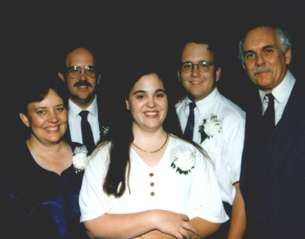
Descendants of Howard Colby Ives in Portland, Oregon,
with Phillip Hinton, 1996.
|
The resolution of personal or inter-personal conflict, is of course, the stuff of good drama. A monologue can soon become dull, like a lecture, so I began to take random incidents from the book which occur in no particular sequence and edit and construct them into a narrative, which is in fact the progress of Ives' spiritual journey - ("a journey from self - to God") undertaken during the Master's time in America. Part of the process was to slightly adapt the rather prosaic 'book-writing' language into something closer to everyday speech, though I was conscious of not overdoing this and losing the 'period' feel of the play...
...I decided to begin with Howard reciting part of the Lord's Prayer from Luke Chapter 11, verse 1, to place his story in its Christian roots from the
outset. (The last lines of the play are from ‘Abdu'l-Bahá's 'Tablet of Visitation'). Throughout the play Howard talks directly to the audience, they are like 'guests' in his drawing room. The different episodes are linked by a kind of commentary, some of which is in the book but for the most part, I imagined him telling the audience, for instance (after the story of the first meeting with the Master) "So! So was born - how can I describe it?
... that mystic bond, that attraction between the seeker and the object of his quest. You know, I have often asked myself how it was that I was chosen for so rare a privelege. But of course, I was not unique in this. He had the power to reach the spiritual centre of each and every soul. How
uncanny was that gift." (Which leads him into the story of arriving at the Kinney home unannounced and uninvited, where he creeps up the stairs to wait for the late diners at luncheon to finish, only to be summoned by ‘Abdu'l-Bahá's voice!) "I was amazed! How could He have known so quickly and so surely that I was there!"
I guess a little over half the text is verbatim from the book and the rest is my interpretation of Ives' character and personality, some of is hinted at in the book and some supported by material received from his descendants who I met during the tour to the US in 1995...
|
pages 18 - 21
Robert Takashi Imagire,
dancer, graphic artist, U.S.A. / the Cook Islands.
|

Left to Right: Moki, DeeDee, and
Robert Imagire.
Performing at the Polynesian club in Reno, Nevada, U.S.A.
|
Decorative art and advertising art were my first interest. After attending the Fine Art School and the American Academy
of Commercial Art in Chicago in the mid '40s, I ended up at the Malcomb Howard Advertising Agency as a commercial artist.
I turned to fine arts, oils mainly, and went back to abstract painting. It was a way to get away from the realism
required at the advertising agency, and to develop my interest in the abstract drawings I saw in the Chicago art
galleries. I started illustrating Florence Mayberry's poem, Man in search of His Soul, which has 19 verses,
each mentioning a Bahá'í month. I started on this as a series of paintings...
...I was inspired by these verses: "the five-pointed man in search for his soul...sometimes an animal drinking from
a river, and sometimes spirit with arms raised longing for heaven.." So I drew a five-pointed figure, which could
represent a generic person and drew that "person" in two parts: one in red, like an animal drinking from a river,
and one blue with arms yearning heavenward...
|
...the real hula is the ancient Kahiko, developed before the introduction of the guitar and ukulele. The instruments (called in Hawai'i "implements")
used were drums ("Toeere"), bamboo sticks ("Pu'ili"), pebbles ("ili ili"), coconut shell halves ("nui"), feather gourds filled with seeds
(like the Mexican "maracas") ("uli uli"), large hollowed-out gourds ("Ipu") and wooded sticks ("kala'au"). Like the belly dance, which was originally Hindu temple dancing, the hula stems from religious ceremonies. Like the Hindu dancing, the early Shinto dances of the Japanese, the dances of the Native Americans, and those of the whirling Dervishes of Iran, hula is a form of worship.
....From 1989 to 1991, I performed with the Berkeley Senior Citizen's hula group for seniors in convelescent homes, hospitals and clinics, as well as for birthday parties and social banquets.
|
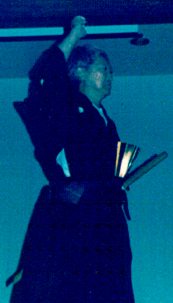
Robert Imagire.
|
During this time, the San Francisco Bahá'í LSA wanted me to bring the Chinese and Chinese Americans to the SF Bahá'í Centre. I found out that the Chinese about my age (then in my 60's) loved social dancing. So I had social dancing classes in the beautiful ballroom of the SF Bahá'í Center. These classes built up until at one time there were 32 Chinese couples attending. The classes taught Fox Trot, Waltz, Cha Cha, Rumba, and Tango. My hula partner and I took lessons in tap, Hungarian, and Irish dances. We put on a two-person show for the Bosch Bahá'í school's classes for the Elder Hosteler program on world religions, world peace, and the cultures of the world. We taught hula, and for the entertainment portion of the Elder Hosteler's graduation, we put on an intercultural show.....
| |
































































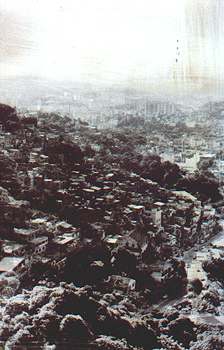


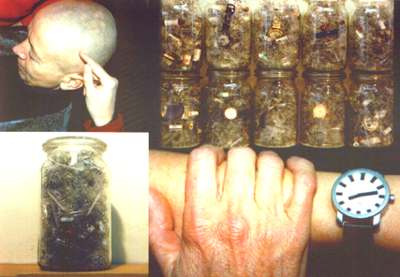 Showing Almost Everything, 2000
Showing Almost Everything, 2000